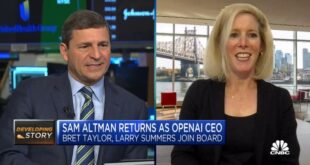
Sean Gallup | Getty Images
A Volocopter 2X electric multirotor helicopter stands on display at the 2017 Frankfurt Auto Show on September 12, 2017 in Frankfurt am Main, Germany. The Frankfurt Auto Show is taking place during a turbulent period for the auto industry. Leading companies have been rocked by the self-inflicted diesel emissions scandal. At the same time the industry is on the verge of a new era as automakers commit themselves more and more to a future that will one day be dominated by electric cars.
With a whirling buzz from 18 rotors, the pilotless helicopter gently lifted off the ground and soared up into the afternoon sky, the spire of the world’s tallest building visible behind it.
The recent unmanned flight by the German-made electric Volocopter represents the latest step in Dubai’s pursuit of flying taxis, which would not seem out of place among the Gulf city’s already futuristic skyline — imagine “Blade Runner,” with less rain.
Dubai already has invested in another model of a flying, autonomous taxi, and is working to design regulations for their use. Putting more passengers in the air could free its already clogged highways and burnish the city’s cutting-edge image of itself.
“It’s public transportation for everybody, so you can use, you can order it, you can pay for the trip and the trip is not much more expensive than with a car,” said Alexander Zosel, Volocopter’s co-founder. “If you build roads, you build bridges, it’s a huge amount and it’s always much more cheaper to have a system where you don’t need that infrastructure.”
Driving in Dubai already makes one yearn for the open skies. Rush hour on Sheikh Zayed Road, a dozen-lane artery running down the length of the city, alternates between dense gridlock and sports-car slalom. Over 1.5 million Dubai-registered vehicles ply its roads, not counting those crowding in from the United Arab Emirates’ six other sheikhdoms.
The Volocopter’s designers envision the electric, battery-powered two-seat helicopters taking off and landing from pads set up across the city. The prototype used in Dubai has a maximum flying time of 30 minutes at 50 kph (31 mph), with a maximum airspeed of 100 kph (62 mph). Batteries charged in climate-controlled areas near the pads would be swapped in as needed.
“I believe (the) urban air taxi will contribute an interesting addition to the existing transportation modes,” Volocopter CEO Florian Reuter said. “There are certain routes that are just extremely beneficial if you can go to the third dimension.”
In practice, however, there’s a long way to go. Convincing white-knuckled flyers to get into a buzzing, pilotless helicopter is just the beginning. Unpiloted passenger flights represent a new frontier for regulators. Dubai’s Road and Transportation Authority, which has invested an undisclosed sum in Volocopter, says it will work the next five years to come up with laws and develop safety procedures.
 EU News Digest Latest News & Updates
EU News Digest Latest News & Updates


